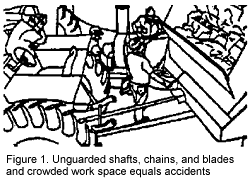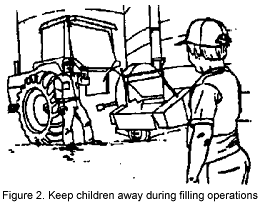Few farming operations provide as many different opportunities for accidents to happen as filling the silo. High powered equipment, working in close quarters, and the possibility of silo gas formation combine to produce numerous accidents throughout the summer and fall. Children wandering around the farmstead make it all the more necessary for farmers to be on the alert for possible accidents.
Initial preparation for filling the silo includes raising the unloader to the top of the structure. Do this on a calm and dry day to lessen the chance of accidental slips and falls. Carefully inspect all cables, wires, pulleys, and connections to see that they are anchored and working properly. One person, at ground level, should raise the unloader while another person watches the process from the blower pipe platform, signaling if lines become tangled or other problems arise. Under no circumstances should anyone enter the silo while the unloader is being raised or attempt to crawl out onto it when it is suspended. A raised unloader can easily crush a worker should it fall.
 The greatest
risk involved in filling the silo stems from the operator
being exposed to a number of moving machine parts in a relatively
crowded work area. Only so much of a self-unloading forage
wagon and silo blower can be guarded. Both are operated by
PTO shafts that many times are not properly guarded. Add unsafe
practices like stepping over shafts or reaching into operating
unloading wagons, and it's easy to see why accidents occur
(see Figure 1).
The greatest
risk involved in filling the silo stems from the operator
being exposed to a number of moving machine parts in a relatively
crowded work area. Only so much of a self-unloading forage
wagon and silo blower can be guarded. Both are operated by
PTO shafts that many times are not properly guarded. Add unsafe
practices like stepping over shafts or reaching into operating
unloading wagons, and it's easy to see why accidents occur
(see Figure 1).
Hazards on self-unloading wagons include a combination of moving aprons, beaters, conveyors or augers, and an assortment of chains and sprockets. To prevent accidents, all protective machinery shields must be in place. Operators should wear comfortable but close-fitting clothing.
Under no circumstances should you ever enter a wagon while the power is on! Nor should you reach into the unloading chute to help speed the unloading rate. If clogging occurs, first disengage the PTO and stop the tractor. PTO's can accidentally slip into gear, particularly if poorly adjusted, or on older tractors, so shutting off the engine is important. Also, keep the unloading wagon's emergency shut-off device in good working condition. It could save your life.
As forage is unloaded from the wagon into the silo blower hopper, it is moved by auger or conveyor to the blower fan which forces it into the silo. The primary hazards of the silo blower are the PTO shaft, the exposed conveyor or auger, and the blower fan blades. Like the forage wagon, silo blower accidents are more likely to occur when the machine plugs up. When this happens, do not climb onto the hopper or use hands or feet to force forage into the blower blades. Before unplugging, disengage the power, shut off the power supply, and make sure the free wheeling blower fan blades have completely stopped turning.
Another danger common to both pieces of equipment is the PTO shaft which drives them. This shaft rotates at either 9 or 16 times per second at full operating speed. Even at slower speeds, no one can react fast enough to pull away once caught by the revolving shaft. Guard yourself from entanglement in the PTO by wearing close-fitting clothing. Also make sure all machinery guards are in place, including knuckles and U-joints at both ends. Walk around tractors and wagons instead of stepping over shafts. Also, securely fasten the silo blower to the tractor drawbar. Otherwise, the PTO could separate or vibrate the blower pipe down.
 Children and unneeded helpers should be restricted from the
immediate area during silo filling (see Figure 2). Persons
around the site who are not essential to the filling operation
not only pose a threat to themselves, but can also increase
the hazard to the machine operator by interfering with his
concentration on the job. Children often consider silo filling
time as fun, and they want to climb on wagons and tractors.
Or a youngster becomes over anxious to help Dad without fully
understanding the hazards associated with the machinery. Make
it a rule to allow only those persons necessary to participate
in filling the silo.
Children and unneeded helpers should be restricted from the
immediate area during silo filling (see Figure 2). Persons
around the site who are not essential to the filling operation
not only pose a threat to themselves, but can also increase
the hazard to the machine operator by interfering with his
concentration on the job. Children often consider silo filling
time as fun, and they want to climb on wagons and tractors.
Or a youngster becomes over anxious to help Dad without fully
understanding the hazards associated with the machinery. Make
it a rule to allow only those persons necessary to participate
in filling the silo.
Finally, machinery operation is not the only type of danger associated with silo filling. Silo gases are also a threat, especially in the first 48-60 hours. If you must enter the silo within the first 48-60 hours, protect yourself by wearing a self-contained breathing apparatus. If you do not have access to one, stay out of the silo. Dangerous levels of silo gas may be present for an additional 2 - 3 weeks. To enter without a self-contained breathing apparatus during this 2 - 3 week period , ventilate with the silo blower. Open all doors, run the blower fan for 20 minutes, and leave it running while you are in the silo. Enter only after you have put on a respirator for toxic dust, and have a second person with you to assist in an emergency.
Remember, filling the silo is a complex operation which involves the hazards of raising heavy equipment, working in close quarters with PTO powered machinery, and exposure to deadly silo gases. While this may sound like a potential disaster area, it needn't be. Understanding the hazards involved and knowing how to correctly work with these hazards will let you have a safe silo filling season. Remember, shut off power before unplugging, walk around revolving shafts, keep children and others way from the worksite, and be on the "alert" for silo gas. See Ag Engineering Fact Sheet Safety-16 for safety recommendations on handling silo gas.
Publication #: 22
This document was published in 1990 as Pennsylvania State University Fact Sheet Safety, Pennsylvania Cooperative Extension Service. For more information, contact Pennsylvania State University College of Agricultural Sciences, Agricultural Engineering Department, 246 Agricultural Engineering Building, University Park, PA 16802.
Dennis J. Murphy, professor, Agricultural Engineering Department, Cooperative Extension Service, Pennsylvania State University, University Park, PA 16802.
Disclaimer and Reproduction Information: Information in NASD does not represent NIOSH policy. Information included in NASD appears by permission of the author and/or copyright holder. More